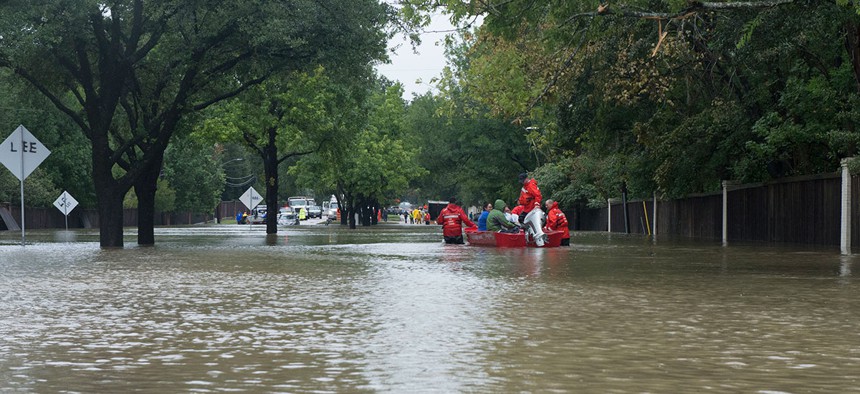
A Coast Guard Flood Punt Team transports a family across a flooded neighborhood in Houston in 2017. Petty Officer 3rd Class Ryan Dickinson / Coast Guard file photo
Why Good Census Numbers Are Vital To Hurricane Recovery
Researchers have four reccomendations for community leaders counting on accurate statistics about their populations in the wake of natural disasters.
New research highlights the effects of natural disasters on the U.S. Census and how it can help with disaster recovery.
With the threat of Hurricane Florence looming over the Carolinas, a group of graduate students at Duke University met with storms on their mind last fall.
“The big picture is that natural disasters happen and the more that communities and states can do to prepare before a natural disaster happens, the better off they will be in terms of their population and infrastructure,” says group member Jennifer Hausman.
“That ties in with the Census… The more you prepare, the better you’ll be for your population to recover and for your government funding and government representation to recover as well, since that is tied to your population count,” Hausman says.
The Census and Representation
“The more I got to learn what the problem was and the huge impact and implications that natural disasters can have for funding, for political seats, and representation—especially for historically underrepresented minorities—I think it’s one of the most important issues that coming up for 2020,” says group member Kristen Jensen.
Hausman, Jensen, and classmates Janna Driskel and Mike Penansky conducted research as part of the final project for a class. The goal of the class was to learn how to conduct applied public policy analysis and produce a set of deliverables for a government or nonprofit client.
For their project, the students partnered with the NALEO Educational Fund, the nonprofit arm of the National Association of Latino Elected and Appointed Officials. The goal of the non-partisan group is to facilitate full Latino participation in the American political process by increasing the effectiveness of Latino policymakers, mobilizing the Latino community to engage in civic life, and promoting policies that advance Latino political engagement.
“The Census has so much importance for representation and adding or taking away representative seats (that) they [NALEO] have a huge push for making the Census for 2020 count and encouraging Latino and Hispanic participation,” says Driskel.
“So the question is how do we mitigate the impact of natural disasters on areas that have high Latino populations that are disproportionately affected by natural disasters, and how can we make sure that they still receive accurate counts to [ensure] they receive the representation and funding that they deserve?”
Hurricane Case Studies
To answer those questions, the students did case studies of three major U.S. hurricanes (Andrew ’92, Katrina ’05, and Ike ’08). They also conducted interviews with experts in a variety of topics, including Census funding allocation, demography, social vulnerability, and disaster displacement.
NALEO invited the students to share their findings at the organization’s annual National Policy Institute on Emergency Preparedness and Response Management Sept. 14-15 in Miami, Fl.
In a bizarre twist of fate, Hurricane Florence almost canceled their trip. But they were able to fly out early, ahead of the storm.
They recommended four ways NALEO members can help ensure an accurate Census count:
- Incorporate socially vulnerable populations into Hazard Mitigation Plans (HMPs): HMPs are more effective when socially and physically vulnerable populations are included in the planning process. After identifying vulnerable populations, local governments should actively seek their involvement in the planning process.
- Encourage local governments to actively participate in Local Update of Census Addresses (LUCA):LUCA, a federal program, provides tribal, local, and state governments an opportunity to review and amend the US Census Bureau’s master address list, in particular to capture unconventional housing units that the Bureau’s records may miss. Active LUCA participation with an emphasis on community-based canvassing, a method that utilizes trusted community members to target “hard-to-count” neighborhoods, ensures a more accurate list of address. This provides more precise enumeration and is essential for measuring displacement in the aftermath of a natural disaster.
- Encourage proactive local government counting efforts: State and local governments also can take proactive steps to ensure accurate enumeration. One good example is AddressNC, a North Carolina project that provides a state-level running database for all addresses. Local governments can also track displacement by using other data sources such as post office forms and FEMA aid registrations.
- Challenge the count: The team notes that local governments can challenge the Census Bureau’s count if they believe their community has been undercounted. This is especially important in the aftermath of a natural disaster where significant displacement, increased residency in unconventional housing, and substantial destruction of homes with verified addresses makes accurate enumeration particularly complicated.
Source: Matt Majsak for Duke University
This article was originally published in Futurity. Edits have been made to this republication. It has been republished under the Attribution 4.0 International license.






